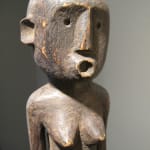Nyamwezi Ancestor Figure, 1870 BCE - 1910 CE
Wood
25.75
LSO.227
Further images
The Nyamwezi (also known as the Wanyamwezi) people of Tanzania are a highly complex polity comprising five separate groups (the Kimbu, Konongo, Nyamwezi, Sukuma, and Sumbwa). Settling in their current...
The Nyamwezi (also known as the Wanyamwezi) people of Tanzania are a highly complex polity comprising five separate groups (the Kimbu, Konongo, Nyamwezi, Sukuma, and Sumbwa). Settling in their current locales in the 1500s, they were mixed agriculturists and pastoralists, although they became increasingly involved with slavery and trading, leaving the tending of herds and lands to migrant Tutsi workers. They oscillated between a series of small chiefdoms and centralized states throughout the European contact period, when their natural resources (especially ivory) and key position made them valuable allies for the competing European powers. Socially, they are in thrall to ancestor cults, and social status – cemented by joining a specialist guild – can be achieved during life (by hunting elephants, for example). Crafts were not taken as seriously as in other African groups, and such occupations were viewed as additional skills, rather than as socially-valid vocations. Their artistic output is configured around ancestor cults, water divination and sorcerers (who guard the village from evil); they also carve secular objects such as anthropomorphic thrones, chairs, combs, horns etc. Their figures tend to be made in dark wood, with elongated midsections, nugatory limbs and a simplified handling of facial features. Most known examples are female – as in the current case – and it is probable that appeals for fertility was one of the main preoccupations of both religious and secular groups. The current sculpture represents an ancestor, which would have been appealed to for supernatural assistance, and treated with reverence in a domestic setting. The piece is large, and has received both libations and extensive handling, as reflected in the dark colouring and the glossy patina. The very specific wear markings on the arms, legs and body suggest that it may once have been ‘dressed’ in mummy-like wrappings, designed to please the spirits and bring benedictions upon the owner. This is a powerful, dramatic and well-carved piece, in superb condition.









